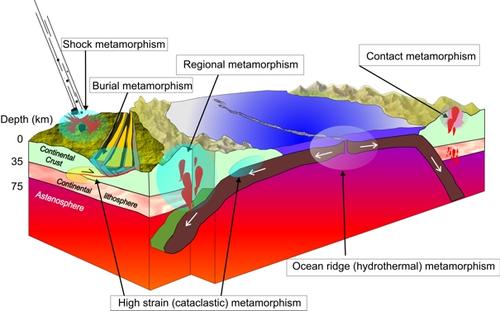Metamorphism
Classification of metamorphism based on geologic setting. This is a commonly used classification because there is a genetic relationship between the metamorphic type and the agent of metamorphism
Image Credit: MBG redrawn from Tarbuck and Lutgnes
Isoclinally folded schist. Sierra de Aconquija. Catamarca. Argentina
Image Credit: MBG
Migmatitic garnet - cordierite - sillimanite metapelite from the high-grade metamorphic Andean basement. Sierra de Quilmes, Salta - Tucumán. Argentina
Image Credit: MBG
Ductily deformed granitic orthogneis. Amanao, Catamarca, Argentina
Image Credit: MBG
Introduction and Overview
Metamorphism and related metamorphic rocks provide valuable and even unique insights into orogenesis, the tectonic evolution of the continental crust, as well as the evolution of the entire planet throughout its recorded history in rocks as old as 4+ Ga.
Mineralogy, texture and field relations show the character of the protolith, such as sedimentary, volcanic, or plutonic, and also record nature and timing of deformational events. These include gradual burial into greater depths of changing pressure and temperature and subsequent uplift. These pressure-temperature-time ("P-T") paths of rock units can be reconstructed due to the constraints of geochronologic data ("P-T-t paths"). Thus, attributes of metamorphic rocks indicate processes of mountain building even though lofty topographic edifices have been eroded a long time ago.
Metamorphism on Earth is almost entirely focused near convergent and divergent plate boundaries because these are the only tectonic regimes where flows of heat and mass are of sufficient magnitude to cause changes in the states of geologic systems and mountain formation processes.
Sources for the metamorphism texts include Best (2003), Winter (2001) and Stelson (Nelson, 2004).
Addition to the Classification:
Classification of metamorphism based on geologic setting. This is a commonly used classification because there is a genetic relationship between the metamorphic type and the agent of metamorphism. There are four categories of metamorphism, namely: contact metamorphism, regional metamorphism, shock metamorphism and high-strain metamorphism



